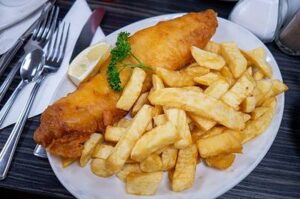The History of Fish and Chips in England
Date post added: 13th November 2023
There’s nothing more comforting and familiar than a fish and chip takeaway. The Friday night trip to the fish and chip shop is as British as a cup of tea or gin and tonic.
Fish and chips are our original fast food takeaway or even street food. And just as today’s British street food originated overseas (think kebabs, falafel, tacos, curry, sushi and noodles), the oh so British dish of fish and chips most likely arrived here with immigrants.
When did the first fish and chip restaurants open?
Team North claim the first fish and chip shop opened in Mossley, near Oldham in Lancashire, around 1863. John Lees sold fried fish and chips from a wooden hut in the market.
But if Team South is to be believed, John Lees was preceded by an East London lad called Joseph Malin who set up shop in 1860. Joseph Malin, a Jewish immigrant, came up with the bright idea of serving fried fish alongside their fried potatoes, and thus the first recorded fish and chip shop launched near Bow in London’s East End.
The history of fish and chips: a timeline
Fish and chips in the 16th century
The quintessentially British working class fare is actually the result of a royal marriage – and we’re not talking about the British royal family. At the end of the 15th century, the King of Portugal married Isabel of Spain. The Spanish Inquisition had already banished Jews from Spain and Isabel insisted that applied to Portugal too.
Sephardic Jews fled their homes with some exiling to England. It was these Jewish immigrants from Portugal and Spain who first brought fried fish to Britain. Their ‘pescado frito’ was fish fried in the Jewish fashion to enjoy on the Sabbath. In Jewish tradition, no cooking is allowed on the Sabbath, so fish was wrapped in batter to preserve it for the following day. Eating fried fish on a Friday soon caught on as a tradition, regardless of religion.
Fish and chips in the 19th century
Fast forward to the 19th century and we’re starting to get a whiff of fried fish accompanied by chips.
In 1837, Charles Dickens published his London based novel, Oliver Twist. In it, he mentions “fried fish warehouses” which were a precursor to our beloved chippie, serving fish with bread or potato. Whilst the potato had landed on British shores back in 1589, it wasn’t coupled with fried fish in its fried form until the 19th century. That’s when the first fish and chip shops opened, as we mentioned earlier. Fried potatoes are named french fries for a reason, as France is where they’re said to originate – but Belgium also claims that crown too.
Then in the 1870s, the Industrial Revolution transformed England, proving a game changer for fish and chips too. New advances like steam trains, steam-trawler boats and ice-packers meant that fresh fish could be stored and transported easily from North Sea ports around the country.
Fish and chips in the 20th century
With more efficient transportation and improved commercial fishing methods, fish became cheaper and readily available. Fish and chip shops opened up in London and across the country. The affordable, hearty meal became a hit, with working class people regularly feasting on the fried fare. By the 1920s there were 35,000 fish and chip shops around the United Kingdom.
During World War II, fish and chips was one of the few food items not to be rationed. British Prime Minister at the time, Winston Churchill, called them “good companions.”
Fish and chips in the 21st century
A trip to the chippy remains popular today. There may be significantly less chippies than in its 1920s heyday, but it’s staple comfort food on menus from pub grub to fine dining. But of course, the best fish and chips is eaten straight out of the paper.
In Britain and Ireland, cod and haddock are the most popular white fish with alternatives including plaice, rock and skate. But with sustainability also on the menu, white fish like pollock are being promoted as alternatives.
How do you eat your fish and chip supper?
Do you eat it as it comes, with a side of tartar sauce or mushy peas? The choice of accompaniment for this quintessentially British food has regional variations. Whilst most places serve mushy peas, gravy and curry sauce are favoured in the north of England, whilst in Scotland it’s brown sauce (or chippy sauce). In the US, tartar sauce or ketchup are firm favourites.
The soft, chubby British fish and chip shop chip soaked in malt vinegar and sprinkled liberally with salt is incomparable with the skinny US french fry or Europe’s slim frite from Belgium and France. Crisp on the outside and super soft and fluffy inside, it’s the chip to beat all chips.
Next time you tuck into a feast from your local chippy, take a moment to reflect on the centuries of tradition that have gone before you. And then pass the salt…
Want to learn more about London food stories? Join Ann on an epicurean adventure around London with her fascinating food tours.


